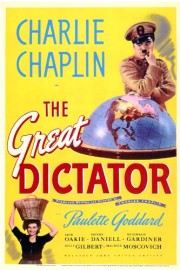The Great Dictator
Thanks to the Hitler meme that grew out of a climactic scene from the brilliant German drama “Downfall,” the world is now safe to laugh at Adolf Hitler again. But for 65 years, that wasn’t the case; the evil at the black heart of the Nazi regime was just too painful. It’s an understandable reaction– no leader in modern history has been so unrepentantly wicked. In 1940 however, Charlie Chaplin dared to attack Hitler with his legendary gift for comedy in “The Great Dictator.” It was the boldest film he ever made, and the last time he played a character with his trademark mustache, which Hitler had taken for his own.
In “The Great Dictator,” Chaplin plays duel roles. The first one is a Jewish barber whom we first see near the end of WWI as he is fighting for the army of Tomania. Through his comic misfortunes, Tomania loses the war, and he ends up with amnesia in a military hospital. This first part of the film is Chaplin’s satirical depiction of the Nazi’s “stabbed in the back” propaganda, which implied that Jews were responsible for the German loss of WWI; this notion was the Nazi’s important tool in fueling hatred for the Jews in Germany.
After a newspaper montage hitting of the key moments of the twenty years after WWI, we catch up with the barber (still in the military hospital, although he’ll soon be out and in the ghetto) and learn that the dictator Hynkel has risen to power. We see an address to the people clearly inspired by Riefenstahl’s “Triumph of the Will,” as Hynkel expounds on how freedom is not worth having, and how Jews should be demonized, although not quite spoken as brutally as Hitler did in real life. The film will follow the barber and Hynkel, which is Chaplin’s second role, as their lives unexpectedly cross paths, and the barber will take the place of the dictator at a crucial point in Tomania’s plans for world domination.
How did Chaplin get away with this? America hadn’t yet entered the war, and many in the country were happy to remain that way. Yet this was the biggest hit of Chaplin’s career, although the values it expounds in the final minutes caused difficulty for the comedic genius, who would eventually spend a great amount of time in exile after the film. At the time, the film’s satirical bite hit with the audacity of “Dr. Strangelove” and “The Producers,” although looking back now, it plays as many of Chaplin’s earlier classics (such as “City Lights” and “Modern Times”) do: a film born out of the vaudeville tradition, aimed more at the broad slapstick of that earlier time than lasting comic appeal.
What remains resonate today about the film is Chaplin’s emotion he feels for the characters in the ghetto and his absurd portrayal of the power hungry Hynkel as a buffoon; the scene where Hynkel (goaded on by his chief adviser Garbage) is inspired to dance around with a balloon globe by the idea of being dictator of the world is a wonderfully silly look at megalomania. And though the climactic scene, where the barber (impersonating Hynkel) expounds on the values of democracy, is much criticized for stopping the laughs in their tracks, and rightfully so; lectures in comedies never work. But even now it remains an important part of the film, which Chaplin made at great risk to his own standing as one of the world’s great entertainers. He remains a national treasure, and “The Great Dictator” remains one of his greatest achievements.










